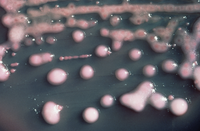
Verification and application of a modified carbapenem inactivation method (mCIM) on Pseudomonas aeruginosa: a potential screening methodology on carbapenemases phenotype in Bacillus cereus
Sign Up to like & getrecommendations! Published in 2022 at "Bioengineered"
DOI: 10.1080/21655979.2022.2072601
Abstract: ABSTRACT Antimicrobial resistance (AMR) has been a leading issue for human health globally threatening the achievement of several of the Sustainable Development Goals (SDGs). Originated from Bacillus cereus, carbapenemases phenotype has been considered to be… read more here.
Keywords: methodology; carbapenem inactivation; inactivation method; carbapenemases phenotype ... See more keywords

Evaluation of the Carbapenem Inactivation Method for Detection of Carbapenemase-Producing Gram-Negative Bacteria in Comparison with the RAPIDEC CARBA NP.
Sign Up to like & getrecommendations! Published in 2017 at "Microbial drug resistance"
DOI: 10.1089/mdr.2016.0092
Abstract: Timely detection of carbapenemases by both phenotypic and genotypic methods is essential for developing strategies to control the spread of infections by carbapenem-resistant isolates and related morbidity and mortality. The aim of this study was… read more here.
Keywords: inactivation method; carbapenem inactivation; detection; rapidec carba ... See more keywords

Is This the Carbapenemase Test We've Been Waiting for? A Multicenter Evaluation of the Modified Carbapenem Inactivation Method
Sign Up to like & getrecommendations! Published in 2017 at "Journal of Clinical Microbiology"
DOI: 10.1128/jcm.00538-17
Abstract: ABSTRACT A plethora of phenotypic methods exist for the detection of carbapenemases; however, clinical laboratories have struggled for years with accurate, objective phenotypic detection of carbapenemase activity in Enterobacteriaceae. In this issue of the Journal… read more here.
Keywords: modified carbapenem; carbapenem inactivation; evaluation modified; microbiology ... See more keywords

EDTA-Modified Carbapenem Inactivation Method: a Phenotypic Method for Detecting Metallo-β-Lactamase-Producing Enterobacteriaceae
Sign Up to like & getrecommendations! Published in 2019 at "Journal of Clinical Microbiology"
DOI: 10.1128/jcm.01757-18
Abstract: The increase in the prevalence and impact of infections caused by carbapenemase-producing Enterobacteriaceae is a global health concern. Therefore, rapid and accurate methods to detect these organisms in any clinical microbiology laboratory, including those in… read more here.
Keywords: inactivation method; carbapenem inactivation; microbiology; method ... See more keywords

Evaluation of the EDTA-Modified Carbapenem Inactivation Method for Detecting Metallo-β-Lactamase-Producing Pseudomonas aeruginosa
Sign Up to like & getrecommendations! Published in 2020 at "Journal of Clinical Microbiology"
DOI: 10.1128/jcm.02015-19
Abstract: The prevalence of carbapenem-resistant Pseudomonas aeruginosa is increasing. Identification of carbapenemase-producing P. aeruginosa will have therapeutic, epidemiological, and infection control implications. This study evaluated the performance of the EDTA-modified carbapenem inactivation method (eCIM) in tandem… read more here.
Keywords: inactivation method; carbapenem inactivation; modified carbapenem; aeruginosa ... See more keywords

Suitability of Carbapenem Inactivation Method (CIM) for Detection of IMP Metallo-β-Lactamase-Producing Enterobacteriaceae
Sign Up to like & getrecommendations! Published in 2017 at "Journal of Clinical Microbiology"
DOI: 10.1128/jcm.02275-16
Abstract: Carbapenem-resistant Enterobacteriaceae (CRE) strains have become globally distributed in the past decade, resulting in concern over the control of hospital infections and antimicrobial therapies ([1][1], [2][2]). The majority of CRE isolates are carbapenemase-producing Enterobacteriaceae (CPE) read more here.
Keywords: carbapenem inactivation; producing enterobacteriaceae; method cim; inactivation method ... See more keywords

The Simplified Carbapenem Inactivation Method (sCIM) for Simple and Accurate Detection of Carbapenemase-Producing Gram-Negative Bacilli
Sign Up to like & getrecommendations! Published in 2018 at "Frontiers in Microbiology"
DOI: 10.3389/fmicb.2018.02391
Abstract: This study reports the simplified carbapenem inactivation method (sCIM) to detect carbapenemase-producing gram-negative bacilli in a simple and accurate manner. This method is based on the modified carbapenem inactivation method (mCIM) with the improvement of… read more here.
Keywords: carbapenemase; carbapenem inactivation; pcr; scim ... See more keywords

Comment on Mitteregger et al. A Variant Carbapenem Inactivation Method (CIM) for Acinetobacter baumannii Group with Shortened Time-to-Result: rCIM-A. Pathogens 2022, 11, 482
Sign Up to like & getrecommendations! Published in 2022 at "Pathogens"
DOI: 10.3390/pathogens11070751
Abstract: We have read the article published by Mitteregger et al. [...]. read more here.
Keywords: carbapenem inactivation; variant carbapenem; mitteregger; inactivation method ... See more keywords